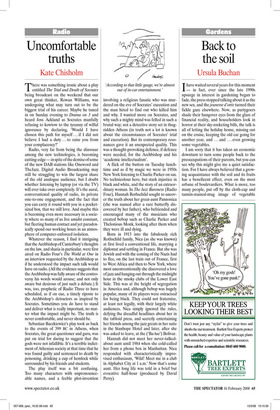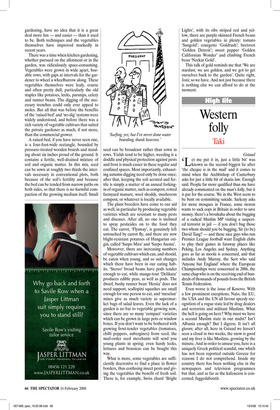Back to the soil
Ursula Buchan
Ihave waited several years for this moment — in fact, ever since the late 1990s upsurge in interest in gardening began to fade, the press stopped talking about it as the new sex, and the jeunesse d’orée turned their fickle gaze elsewhere. Now, as partygoers shade their hungover eyes from the glare of financial reality, and householders look in horror at their sky-rocketing bills, the talk is all of letting the holiday home, missing out on the cruise, keeping the old car going for another year, and ... and ... even growing some vegetables.
I am sorry that it has taken an economic downturn to turn some people back to the preoccupations of their parents, but you can see why this might give me a quiet satisfaction. For I have always believed that a growing acquaintance with the soil and its fruits has a beneficent effect, even on the most urbane of boulevardiers. What is more, too many people, put off by the cloth-cap and tannin-stained-mug image of vegetable gardening, have no idea that it is a great deal more fun — and easier — than it used to be. Both techniques and the vegetables themselves have improved markedly in recent years.
There was a time when kitchen gardening, whether pursued on the allotment or in the garden, was ridiculously space-consuming. Vegetables were grown in wide apart, hoeable rows, with gaps at intervals for the gardener to wheel a wheelbarrow along. These vegetables themselves were leafy, coarse and often pretty dull, particularly the old staples like potatoes, leeks, parsnips, celery and runner beans. The digging of the necessary trenches could only ever appeal to moles. But all that was before the benefits of the ‘raised bed’ and ‘no-dig’ systems were widely understood, and before there was a rich variety of vegetable cultivars that suited the private gardener as much, if not more, than the commercial grower.
A raised bed, if you have never seen one, is a four-foot-wide rectangle, bounded by pressure-treated wooden boards and standing about six inches proud of the ground. It contains a fertile, well-drained mixture of soil and organic matter. In this mix, seed can be sown at roughly two thirds the intervals necessary in conventional plots, both because of the soil’s fertility and because the bed can be tended from narrow paths on both sides, so that there is no harmful compaction of the growing medium itself. Small seed can be broadcast rather than sown in rows. Yields tend to be higher, weeding is a doddle and physical protection against pests and frost is much easier in these regular and confined spaces. Most importantly, exhausting autumn digging need only be done once; after that, keeping the soil aerated and fertile is simply a matter of an annual forkingin of organic matter, such as compost, rotted farmyard manure, wool shoddy, mushroom compost, or whatever is locally available.
The plant breeders have come to our aid as well, in particular by producing vegetable varieties which are resistant to many pests and diseases. After all, no one is inclined to spray pesticides on to the food they eat. The carrot, ‘Flyaway’, is genuinely left untouched by carrot fly, and there are now blight-resistant potatoes of Hungarian origin, called ‘Sarpo Mira’ and ‘Sarpo Axona’.
Moreover, there are increasing numbers of vegetable cultivars which can, and should, be eaten when young, and so suit changes which there have been in our eating habits. ‘Stereo’ broad beans have pods tender enough to eat, while mange-tout ‘Delikata’ produces edible peas, as well as pods. The dwarf, bushy runner bean ‘Hestia’ does not need support, scallopini squashes are small enough for one person to eat, and ‘mesclun’ mixes give as much variety as supermarket bags of salad leaves. Even the lack of a garden is no bar to vegetable growing now, since there are so many ‘compact’ varieties which can be grown in large pots or window boxes. If you don’t want to be bothered with growing frost-tender vegetables (tomatoes, chilli peppers, aubergines) from seed, the mail-order seed merchants will send you young plants in spring; even hardy leeks, lettuces and brassicas can be bought this way.
What is more, some vegetables are sufficiently decorative to find a place in flower borders, thus confusing insect pests and giving the vegetables the benefit of fresh soil. There is, for example, Swiss chard ‘Bright Lights’, with its ribs striped red and yellow, there are purple-skinned French beans and golden vegetables in plenty: tomato ‘Sungold’; courgette ‘Goldrush’; beetroot ‘Golden Detroit’; sweet pepper ‘Golden Californian Wonder’ and climbing French bean ‘Neckar Gold’.
This talk of gold reminds me that ‘We are stardust, we are golden, and we got to get ourselves back to the garden’. Quite right, Joni; so we have. And not just because there is nothing else we can afford to do at the moment.



















































































 Previous page
Previous page